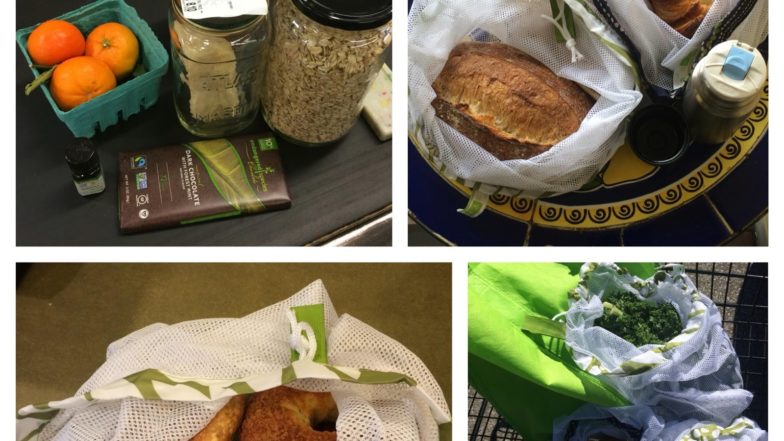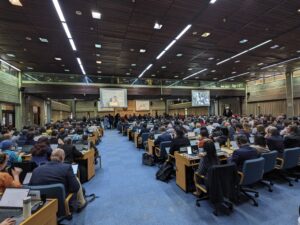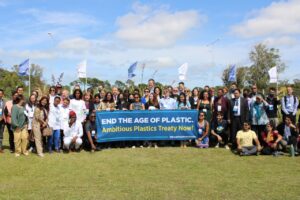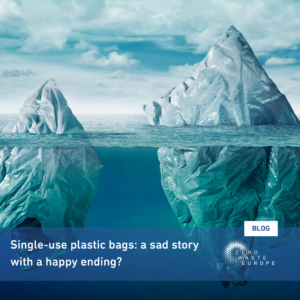How a simple 40-day experiment rocked my world

As we reach the end of the Zero Waste Week, where various experiments have taken place in finding new ways to live without producing waste such in our daily lives. This account from guest blogger Mirabai Weismehl Rosenfeld, details her experiment of living without single use plastics for 40 days. Read about her trials and tribulations below…
 Have you ever been struck by how much plastic there is? On many occasions over the years, friends and I would comment on the ever-increasing abundance of plastic packaging that we were recycling or throwing away every few days from our homes. It seemed wasteful. After considering the true cost of production, even recycling, which is considered by most to be a responsible solution, seemed energy-intensive compared to the few minutes of use for which the packaging was designed. Plus, we didn’t even know if the city had the processing facilities to recycle all of the odd mixes of plastic. In Grandma’s time, it wasn’t like this! Though troubled by the situation, we would undoubtedly give ourselves a pat on the back for talking about our concern for the environment. I realise now in retrospect that it was merely that: talk. There is a saying, “When all is said and done, more is said than done”.
Have you ever been struck by how much plastic there is? On many occasions over the years, friends and I would comment on the ever-increasing abundance of plastic packaging that we were recycling or throwing away every few days from our homes. It seemed wasteful. After considering the true cost of production, even recycling, which is considered by most to be a responsible solution, seemed energy-intensive compared to the few minutes of use for which the packaging was designed. Plus, we didn’t even know if the city had the processing facilities to recycle all of the odd mixes of plastic. In Grandma’s time, it wasn’t like this! Though troubled by the situation, we would undoubtedly give ourselves a pat on the back for talking about our concern for the environment. I realise now in retrospect that it was merely that: talk. There is a saying, “When all is said and done, more is said than done”.
Fast forward to 2016. While on sabbatical in the United States last year, a friend of mine told me that for Lent she was going to give up eating meat. I don’t practice any particular religion, just my violin, but I was inspired to give something up for Lent, too. What would it be? 40 days is a long time. What would be a challenge and, at the same time, help align my actions with my beliefs? I got it! I decided to give up plastic – all of those petroleum-based SUPs (Single-Use Plastics). So, what does that include? It’s the disposable plastic water cup, coffee cup and lid, water bottle, drinking straw, ice cream spoon, styrofoam, cling film wrap, produce bag, etc. The list goes on and on.
Could I buy what I wanted without plastic waste? I wasn’t sure.
What would I eat? Would I go hungry?
What could I buy within these guidelines?
I really didn’t know the answers to these questions, so I would have to see in person with my newly trained plastic-detector eyes. As motivation, I called this an “experiment”. Experiments are low-risk, in the sense that they allow for failure, and I would simply do my best, learning and adjusting each step of the way. I posted on social media in order to be held accountable and also to see if others would be interested in joining me. Immediately, over 70 friends and relatives responded with support and 8 people in different locations around the world even agreed to do the experiment with me! I also got comments such as, “I’ve tried this. I didn’t last a week.” Most agreed that there is too much plastic packing in general, but sensed little hope for a change, blaming the manufacturers for giving us no options. Others suggested shopping locally from farmers or at farmers’ markets. This has proven to be, in every location I have lived or traveled, the most viable option, as there is little to no packaging. While buying organic foods directly from the farmers, I also intentionally decided to extend my experiment to conventional supermarkets, where the vast majority shop. I chose to make a statement every time, voting with my money, buying the products which did not use SUPs; and for those which did use SUPs, I called the company, expressing to them that I won’t be buying those products because of my experiment. My calls were usually received by a shocked secretary who agreed to deliver my message. I bet they rarely got such calls!
In order to start my shopping experiment, I decided that I would have to prepare some items, namely reusable cloth bags:
My loyal durable, washable and lightweight shopping bag – always in my pocket or purse
Mesh bags with drawstrings – ideal produce bags for loose fruit or green leafy vegetables
Solid cloth bags for bulk items such as grains, nuts, seeds or dried fruit
Some shopkeepers hesitated putting food in my bags, saying that they might get stained. They can get stained and then washed! I would gladly accept a temporary stain in exchange for keeping a plastic bag out of landfill. (By the way, I advise washing new cloth bags before first use, just as you would new clothing before wearing.) A year later, this system works just as well in Europe, where in supermarkets, it is required to weigh produce and print a price sticker – stick it on the cloth bag and then checking out is effortless. I bought my bags but if you have fabric and a sewing machine, you can make your own!
So, how was my first shopping trip? I was overwhelmed by the size of the monster I had just challenged. It hit me suddenly, like a rude awakening. I saw the plastic. I saw it everywhere. Whereas before, I had focused on the product inside, now all I could see was the plastic prison on the outside. It wrapped carrots and celery. It clung to fruit. Cheeses suffocated in it. Cans were lined with it, I found out. Every kind of prepared and processed food was enveloped in it. You will understand, too, if you start looking.

And I did not want to buy it! My new experiment was a kind of game, but at a certain point of saturation, seeing so much unnecessary plastic was repulsive. By being prepared though, I managed to avoid consuming 2 plastic shopping bags, 5 thin plastic produce bags, plastic clamshells, styrofoam and plastic cling film! An encouraging beginning. Unsure of the reaction I would get in a store not accustomed to Zero Waste, I admit that I was a bit nervous at first, but as I got the hang of it, I even showed off a bit. I got some attention from fellow shoppers as well as from the cashier, noting with curiosity that this was something different from the norm. It was so successful that I was convinced to make it the new norm. With this mindset, I felt like a warrior on a mission!
Many times in subsequent shopping trips, honestly I felt disoriented and hungry, not being able to buy what I was used to buying. Crackers, chips and pasta all came in disposable plastic bags. Yogurt, juice, and prepared foods were in plastic containers. Sometimes I would even buy a food I didn’t know – just because it came in glass or no packaging at all – and then learn how to prepare it. A friend of mine who heard about my 40-day experiment recommended the book Zero Waste Home by Bea Johnson. I borrowed a copy from the local library. The book is a marvellous resource, with a multitude of recipes for a Zero Waste lifestyle. One of the first practical tips I could apply immediately was shopping the perimeter of a supermarket – generally where one finds unpackaged produce, fresh meat, cheese and fish, or bread and pastries, all of which one could ideally put in bags or glass containers brought to the store. Other bright minds, such as Michael Pollan, have also noticed this supermarket design. Take a look next time you go shopping.

The first few attempts were clearly the hardest, but gradually I developed a routine, and store workers started recognising me. Each time though, I would still get a little pit in my stomach, not knowing what challenge I would have to face. For example, empty glass jars are heavy and require the tare weight to be calculated before filling – some registers could not subtract that. On other occasions, managers would run after me, questioning the sterilisation of my containers and bags. I assured them that they were sterilised by the high heat of the dishwasher and washing machine. On days when I was tired, I would go to the people who knew me and understood without explanation. On days when I had energy to burn, I would intentionally go to different workers, ask for help, explain what I was doing, make suggestions and enjoy the surprise, shock or understanding on their faces. For example, at the deli counter, when I asked for cheese to be sliced and put in my glass container, the worker paused for a moment, looked at me as she put the cheese in and commented, “Ya learn somethin’ new every day!”
So, I came to the end of the 40-day experiment. Could I have wasted less and been more prepared? Yes. But all in all, I was quite pleased with the results. This is all of the plastic waste I created:

CONCLUSION
Buying food without plastic packaging is possible and I ended up eating healthier and saving money! On day 41, with the relief of having concluded my experiment, did I revert to buying plastic packaging as I had before? No, I realised that there was no turning back. It was a simple decision. Even if it is easier in the short-term to use SUPs and other disposable items, I’m willing to make the relatively small effort in order to avoid undesirable, and potentially disastrous, long-term effects. Not only do they create waste, use excessive resources, energy and money, but they also leach into the food. Why voluntarily eat disease-provoking chemicals? Better not to buy unnecessary packaging in the first place! All that being said, I must clarify that, contrary to what you may deduce, I do value plastic for its amazing qualities. What I am opposed to is its overuse and abuse, financially profiting some greedy corporations while jeopardising the health of life on this planet.
Regarding “Zero Waste”, I have found it to be a lofty lifestyle goal. Intentionally following the principles has significantly improved my quality of life. By being an example of the change I want, I revel in changing people’s views (most importantly, my own) on what is possible, acceptable and ‘normal’. My parents raised me with a strong environmental consciousness, according to the philosophy of Zero Waste, though it had not yet been named. When talking with various people on this subject, quite a few respond that they remember, even in their own generation, the times of glass milk bottles and cloth bags. In fact, this is not a new lifestyle. It is a return to the wisdom of our elders. In the past 70-some years, stores have made it increasingly difficult to shop like this, so that is why I evaluated my 40-day experiment as a tremendous victory! Globally, we’ve reached a point at which the way we are consuming is neither sustainable nor intelligent. It is time to wake up and take action! Educating oneself and consequently aligning one’s actions with one’s beliefs is positively empowering. If you already are doing this, I commend you. Share your story and inspire others.
My recommendation to anyone wishing to do this experiment: focus on the concept, not necessarily the number Zero. My shopping partner, doing the experiment with me, was striving for a 75% reduction in wasteful packaging and was successful! If you can reduce consumption of SUPs by 50%, for example, that’s a marvelous step! Even a 20% reduction is something. You might start by simply noticing plastic around you, whether in the store, at a restaurant or the bags that people carry on the street. Every little bit does help. In the words of Dr. Robert Maurer, “One small step can change your life!” So many of us are in professions that demand precision and perfectionism. Striving for that same perfection, as in a perfect 0% waste score, can be paralyzing. My intention has become rather to reduce waste as much and as quickly as possible, but not to keep score. Being the type of person who has the best intentions and yet is not perfect, I jokingly mentioned to my experiment partner that we could form the “2% Waste” Club. Our simultaneous outburst of laughter initiated the club.
What had started as merely a 40-day experiment turned into a chain of experiments, one clue leading to the next. Each successful one has, in turn, led to a certain personal awakening, if you will, becoming another part of my chosen lifestyle.“What had started as merely a 40-day experiment turned into a chain of experiments, one clue leading to the next. Each successful one has, in turn, led to a certain personal awakening, if you will, becoming another part of my chosen lifestyle.”


